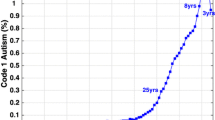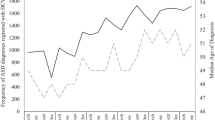Abstract
There has been little evidence to support the hypothesis that diagnostic substitution may contribute to increases in the administrative prevalence of autism. We examined trends in assignment of special education codes to British Columbia (BC) school children who had an autism code in at least 1 year between 1996 and 2004, inclusive. The proportion of children with an autism code increased from 12.3/10,000 in 1996 to 43.1/10,000 in 2004; 51.9% of this increase was attributable to children switching from another special education classification to autism (16.0/10,000). Taking into account the reverse situation (children with an autism code switching to another special education category (5.9/10.000)), diagnostic substitution accounted for at least one-third of the increase in autism prevalence over the study period.

Similar content being viewed by others
Notes
Generally, children in British Columbia are required to enroll in an educational program “…on the first day of a school year if, on or before December 31 of that school year, the person will have reached the age of 5 years.” However, parents may opt to defer enrollment of their child until the first school day of the next school year (British Columbia Ministry of Education 2006b). Accordingly, we considered a child to be at the age of mandatory school enrolment if he or she was 6 years of age or under as of December 31, and above the age of mandatory school enrollment if he or she was 7 years of age or over as of December 31 of a given year.
References
American Psychiatric Association. (1994). Diagnostic and Statistical Manual of Mental Disorders (DSM-IV) (4th ed.) Washington: American Psychiatric Association.
Blaxill, M. F. (2004). What’s going on? The question of time trends in autism. Public Health Reports, 119, 536–551.
Blaxill, M. F., Baskin, D. S., & Spitzer, W. O. (2003). Commentary: Blaxill, Baskin, and Spitzer on Croen et al. (2002) The changing prevalence of autism in California. Journal of Autism and Developmental Disorders, 33, 4920.
British Columbia Ministry of Education. (2002). Ministry policy site. Policy document: K-12 funding—Special needs. Retrieved April 23, 2007 from http://www.bced.gov.bc.ca/policy/policies/funding_special_needs.htm
British Columbia Ministry of Education. (n.d.). Special education services: A manual of policies, procedures and guidelines. Retrieved April 30, 2007 from http://www.bced.gov.bc.ca/specialed/ppandg/planning_11.htm
British Columbia Ministry of Education. (2006a). Province funds students with autism spectrum disorder. Retrieved April 23, 2007 from http://www2.news.gov.bc.ca/news_releases_2005–2009/2006EDU0104-001205.htm
British Columbia Ministry of Education. (2006b). Manual of school law K to 12 (online). Retrieved November 5, 2006 from http://www.bced.gov.bc.ca/legislation/schoollaw/
British Columbia Ministry of Education Special Programs Branch. (2000). Teaching students with autism. A resource guide for schools. [RB0102]. Retrieved December 4, 2006 from http://www.bced.gov.bc.ca/specialed/docs/autism.pdf
Caronna, E. B., & Hall, A. J. (2005). Dipping deeper into the reservoir of autistic spectrum disorder. Archives of Pediatric and Adolescent Medicine, 157, 619–621.
Charman, T. (2002). The prevalence of autism spectrum disorders: Recent evidence and future challenges. European Child and Adolescent Psychiatry, 11, 249–256.
Croen, L. A., & Grether, J. K. (2003). Response: A response to Blaxill, Baskin, and Spitzer on Croen et al. (2002), “The changing prevalence of autism in California”. Journal of Autism and Developmental Disorders, 33, 227–229.
Croen, L. A., Grether, J. K., Hoogstrate, J., & Selvin, S. (2002). The changing prevalence of autism in California. Journal of Autism and Developmental Disorders, 32, 207–215.
Fombonne, E. (2003). The prevalence of autism. The Journal of the American Medical Association, 289, 87–89.
Gurney, J. G., Fritz, M. S., Ness, K. K., Sievers, P., Newschaffer, C. J., & Shapiro, E. G. (2003). Analysis of prevalence trends of autism spectrum disorder in Minnesota. Archives of Pediatric and Adolescent Medicine, 157, 622–627.
Howlin, P., & Asgharian, A. (1999). The diagnosis of autism and Asperger syndrome: Findings from a survey of 770 families. Developmental Medicine & Child Neurology, 41, 834–839.
Laidler, J. R. (2005). US Department of Education data on “autism” are not reliable for tracking autism prevalence. Pediatrics, 116, e120–e124.
Lingam, R., Simmons, A., Andrews, N., Miller, E., Stowe, J., & Taylor, B. (2003). Prevalence of autism and parentally reported triggers in a north east London population. Archives of Disease in Childhood, 88, 666–670.
Lord, C., & Risi, S. (2001). Diagnosis of autism spectrum disorders in young children. In A. M. Wetherby & B. M. Prizant (Eds.), Autism spectrum disorders: A transactional developmental perspective (pp. 11–30). London: Paul H Brookes.
Magnússon, P., & Sæmundsen, E. (2001). Prevalence of autism in Iceland. Journal of Autism and Developmental Disorders, 31, 153–163.
Mandell, D. S., Listerud, J., Levy, S. E., & Pinto-Martin, J. A. (2002). Race differences in the age at diagnosis among Medicaid-eligible children with autism. Journal of the American Academy of Child & Adolescent Psychiatry, 41, 1447–1453.
Mandell, D. S., & Palmer, R. (2005). Differences among states in the identification of autistic spectrum disorders. Archives of Pediatric and Adolescent Medicine, 159, 266–269.
Newschaffer, C. J. (2006). Investigating diagnostic substitution and autism prevalence trends [commentary]. Pediatrics, 117, 1436–1437.
Newschaffer, C. J., & Curran, L. K. (2003). Autism: An emerging public health problem. Public Health Reports, 118, 393–399.
Newschaffer, C. J., Falb, M. D., & Gurney, J. G. (2005). National autism prevalence trends from United States special education data. Pediatrics, 115, e277–e282.
Ouellette-Kuntz, H., Coo, H., Lloyd, J. E. V., Kasmara, L., Holden, J. J. A., & Lewis, M. E. S. (2007). Trends in special education code assignment for autism: Implications for prevalence estimates. Journal of Autism and Developmental Disorders. doi: 10.1007/s10803-007-0478-x.
Shattuck, P. T. (2006). The contribution of diagnostic substitution to the growing administrative prevalence of autism in US special education. Pediatrics, 117, 1028–1037.
Volkmar, F. R., Lord, C., Bailey, A., Schultz, R. T., & Klin, A. (2004). Autism and pervasive developmental disorders. Journal of Child Psychology and Psychiatry, 45, 135–170.
Wiggins, L. D., Baio, J., & Rice, C. (2006). Examination of the time between first evaluation and first autism spectrum disorder diagnosis in a population-based sample. Developmental and Behavioral Pediatrics, 27, S79–S87.
Wing, L., & Potter, D. (2002). The epidemiology of autistic spectrum disorders: Is the prevalence rising? Mental Retardation and Developmental Disabilities Research Reviews, 8, 151–161.
Acknowledgments
We wish to thank Ms. Nancy Walt, Ms. Caroline Ponsford and Ms. Claudia Roch of the British Columbia Ministry of Education, and Dr. Victor Glickman, Director of Edudata Canada, for providing us with access to the information resources of the British Columbia Ministry of Education through Edudata Canada that were integral to this study. We also wish to thank Ms. Sarah Moffat, a Psychology student at Queen’s University, for her assistance with the preparation of this manuscript. We are grateful to the members of the Autism Spectrum Disorders-Canadian-American Research Consortium (ASD-CARC; Jeanette J.A. Holden, Principal Investigator) for their work on the grant proposal that led to the funding of this and other ASD-CARC projects, and to other members of the ASD-CARC Epidemiology Project team for their contribution to the overall project. Members of these groups are listed on the ASD-CARC’s website at http://www.autismresearch.ca. This work was supported by a CIHR Interdisciplinary Health Research Team grant (RT-43820) to the ASD-CARC. Dr. Suzanne Lewis sincerely appreciates the support provided by the CIHR Institute of Genetics Clinician Investigator (2003–2005) and the Michael Smith Foundation for Health Research Scholar Programs (2005–2010). The findings and interpretations expressed herein are those of the authors, and do not necessarily reflect the opinions of the British Columbia Ministry of Education or of Edudata Canada.
Author information
Authors and Affiliations
Corresponding author
Rights and permissions
About this article
Cite this article
Coo, H., Ouellette-Kuntz, H., Lloyd, J.E.V. et al. Trends in Autism Prevalence: Diagnostic Substitution Revisited. J Autism Dev Disord 38, 1036–1046 (2008). https://doi.org/10.1007/s10803-007-0478-x
Received:
Accepted:
Published:
Issue Date:
DOI: https://doi.org/10.1007/s10803-007-0478-x




